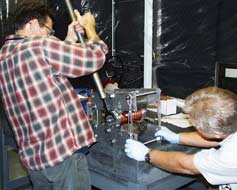
Handy Links
SLAC News Center
SLAC Today
- Subscribe
- Archives: Feb 2006-May 20, 2011
- Archives: May 23, 2011 and later
- Submit Feedback or Story Ideas
- About SLAC Today
SLAC News
Lab News
- Interactions
- Lightsources.org
- ILC NewsLine
- Int'l Science Grid This Week
- Fermilab Today
- Berkeley Lab News
- @brookhaven TODAY
- DOE Pulse
- CERN Courier
- DESY inForm
- US / LHC
SLAC Links
- Emergency
- Safety
- Policy Repository
- Site Entry Form

- Site Maps
- M & O Review
- Computing Status & Calendar
- SLAC Colloquium
- SLACspeak
- SLACspace
- SLAC Logo
- Café Menu
- Flea Market
- Web E-mail
- Marguerite Shuttle
- Discount Commuter Passes
-
Award Reporting Form
- SPIRES
- SciDoc
- Activity Groups
- Library
Stanford
Around the Bay
LARP Lends a Hand to "Dream Machine"
 Building the world's most powerful particle accelerator, the Large Hadron Collider (LHC), requires the work of many hands and a whole lot of brain power. Fortunately, "the whole world wants to participate in this," says SLAC physicist Alex Chao, "because it's a unique accelerator and a unique program."
Building the world's most powerful particle accelerator, the Large Hadron Collider (LHC), requires the work of many hands and a whole lot of brain power. Fortunately, "the whole world wants to participate in this," says SLAC physicist Alex Chao, "because it's a unique accelerator and a unique program."
Among those already involved in the development of the LHC, which is on track to begin full operations in 2008, is a group of SLAC scientists belonging to the U.S. LHC Accelerator Research Program (LARP). LARP provides accelerator science and technology support to the LHC project, and its efforts promise to benefit both SLAC and CERN, the European laboratory that houses the accelerator.
Three other national laboratories—Brookhaven, Fermilab, and Lawrence Berkeley—also participate in LARP, with each contributing its own expertise to the project. SLAC's current focus, under the direction of Tom Markiewicz, is on designing a prototype collimator, a device that defines the size and shape of a particle beam. SLAC scientists have previous experience developing collimators for the proposed International Linear Collider.
Although the lab joined the LARP collaboration about three years ago, the group's major work still lies ahead. That's because the LHC is entering its commissioning phase, a test phase of sorts that will call upon the skills and expertise of LARP. "The fun starts with the commissioning," says Chao. "Every accelerator is different and alive, and you have to try to understand every little piece of it."
LARP will continue to play a role after commissioning, during the LHC's projected upgrade phase, when scientists will look for ways to improve the accelerator beyond its initial design.
Some of the issues that the SLAC team, dubbed LARP@SLAC, will tackle next include interaction region optimization, beam-beam interactions, instrumentation and beam-based corrections. The lab will host a beam-beam interaction workshop in spring 2007, and a national LARP meeting in spring 2008.
"LARP is important to CERN," says Chao, "but it is equally important for SLAC and the U.S. accelerator community." In addition to helping CERN solve the technical challenges that come with building the world's most powerful particle accelerator, two other major goals of LARP are to advance the skills and capabilities of the domestic accelerator community, and to train the next generation of U.S. accelerator experts. "We really want to send young physicists over to the LHC and get them involved," says Chao.
Chao chairs the LARP@SLAC committee, which includes Uli Wienands and Nan Phinney, and encourages others at SLAC to get involved with LARP. "We encourage people to bring their thoughts to us, or even to volunteer," he says. "It's an opportunity to participate in the development of a dream machine."
—Jennifer Yauck
SLAC Today, December 8, 2006
Above image: LARP members Eric Doyle and Steve Lundgren wind a copper cooling tube around a copper spool piece as they work out the manufacturing process for a LHC collimator prototype. (Image courtesy of Gene Anzalone.)